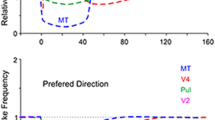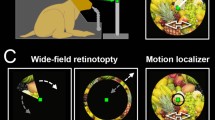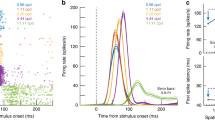Summary
The response properties of 633 neurons from striate and prestriate cortex were recorded in 3 hemispheres of two awake cynomolgus monkeys while they fixated or tracked a small spot of light. Of 254 penetrations located at 1 mm intervals, 39% were identifiable from visible electrolytic lesions or electrode tracks and were used to reconstruct the positions of all recording sites. A total of 226 cells were located in the superior temporal sulcus and 81 cells in area V1. The location and visuotopic organization of the foveal portion of the middle temporal (MT) visual area were determined in three hemispheres. MT was defined physiologically on the basis of direction-selectivity, receptive field size, and retinotopic organization. Of 170 MT neurons, most were motion sensitive, and 65% had a directionality index, (best — opposite)/best, of 0.6 or higher. MT was defined anatomically on the basis of myelin staining within the superior temporal sulcus (STS). On the posterior bank of the STS the physiologically defined border corresponded closely to a myelin border visible on our sections. Distinct myelin borders were not consistently identifiable on the anterior bank. The representation of the central fovea (eccentricities of 0–1 deg) was located partly on the floor, but mostly on the posterior bank of the STS at the extreme postero-lateral edge of MT. In all three hemispheres foveal MT extended onto the roof of a cleft formed between the posterior bank and a wide flattened area on the floor of the STS. This region lies 10–12 mm below the brain surface, measuring along a line normal to the surface at a point 2–3 mm antero-lateral to foveal V1. The area of MT was 6–9 mm2 for the central fovea (0–1 deg), 15–24 mm2 for the entire fovea (0–3 deg), and 28–40 mm2 including the fovea and parafovea (0–10 deg). A visuotopic map of central foveal V1 (0–1 deg) was obtained in one animal. The measured area of this representation was 116 mm2. Using published estimates of the total areas of cynomolgus MT and V1 (73 and 1200 mm2 respectively) the ratio of central foveal to total area was calculated to be 0.10 for both MT (7.5/73) and V1 (116/1200), indicating that the relative magnification of the foveal versus the peripheral visual field is preserved in the mapping of V1 onto MT. A separate representation of the central visual field was found immediately adjacent to foveal MT. This region, the FST area (Ungerleider et al. 1982; Ungerleider and Desimone 1986a, b), was distinguishable from MT in three ways: 1) by the presence of occasional visually unresponsive cells, 2) by the presence of cells with very large receptive fields intermingled with cells whose receptive fields are comparable in size to those found in foveal MT, and 3) by an increased incidence of cells responding during tracking. Of 34 FST neurons, 53% had a directionality index of 0.6 or higher. An additional 22 cells recorded in the superior temporal sulcus were judged to be outside both MT and FST.
Similar content being viewed by others
References
Albright TD, Desimone R (1987) Local precision of visuotopic organization in the middle temporal area (MT) of the macaque. Exp Brain Res 65:582–592
Allman JM, Kaas JH (1971a) Representation of the visual field in striate and adjoining cortex of the owl monkey (Aotus trivirgatus). Brain Res 35:89–106
Allman JM, Kaas JH (1971b) A representation of the visual field in the caudal third of the middle temporal gyrus of the owl monkey (Aotus trivirgatus). Brain Res 31:85–105
Allman JM, Kaas JH (1974) A crescent-shaped cortical visual area surrounding the middle temporal area (MT) in the owl monkey (Aotus trivirgatus). Brain Res 81:199–213
Allman JM, Kaas JH, Lane RH (1973) The middle temporal visual area (MT) in the bushbaby, Galago senegalensis. Brain Res 57:197–202
Baker JF, Peterson SE, Newsome WT, Allman JM (1980) Visual response properties of neurons in four extrastriate visual areas of the owl monkey (Aotus trivirgaus): a quantitative comparison in the medial (M), dorsomedial (DM), dorsolateral (DL), and middle temporal (MT) areas. J Neurophysiol 45:397–416
Bauer R, Dow BM, Vautin R (1983) Orientation shift between upper and lower layers in monkey visual cortex. Exp Brain Res 50:133–145
Cragg BG, Ainsworth A (1969) The topography of the afferent projections in the circumstriate visual cortex of the monkey studied by the Nauta method. Vision Res 9:733–747
Daniel PM, Whitteridge D (1961) The representation of the visual field on the cerebral cortex in monkeys. J Physiol 159:203–221
Desimone R, Ungerleider LG (1986) Multiple visual areas in the caudal superior temporal sulcus of the macaque. J Comp Neurol 248:164–189
Dow BM (1974) Functional classes of cells and their laminar distribution in monkey visual cortex. J Neurophysiol 37:927–946
Dow BM, Snyder AZ, Vautin RG, Bauer R (1981) Magnification factor and receptive field size in foveal striate cortex of the monkey. Exp Brain Res 44:213–228
Dow BM, Vautin RG, Bauer R (1985) The mapping of visual space onto foveal striate cortex in the macaque monkey. J Neurosci 5:890–902
Dubner R, Zeki SM (1971) Response properties and receptive fields of cells in an anatomically defined region of the superior temporal sulcus in the monkey. Brain Res 35:528–532
Emmert KH, Hoffmann KP (1986) Cortical areas mediating optokinetic information in the squirrel monkey. Soc Neurosci Abstr 12:432
Erickson RG (1985) Representation of the fovea and identification of foveal tracking cells in the superior temporal sulcus of the macaque monkey. PhD thesis. State University of New York at Buffalo
Erickson RG, Dow BM (1989) Foveal tracking cells in the superior temporal sulcus of awake macaque monkeys. Exp Brain Res 78:113–131
Evarts EV (1966) Methods for recording activity of individual neurons in moving animals. Methods Med Res 11:241–250
Gallyas R (1979) Silver staining of myelin by means of physical development. Neurol Res 1:203–209
Gattass R, Gross CG (1981) Visual topography of striate projection zone (MT) in posterior superior temporal sulcus of the macaque. J Neurophysiol 46:621–638
Hubel DH, Wiesel TN (1972) Laminar and columnar distribution of geniculo-cortical fibers in the macaque monkey. J Comp Neurol 146:421–450
Judge SJ, Richmond BJ, Chu FC (1980) Implantation of magnetic search coil for measurement of eye position: an improved method. Vision Res 20:535–538
Komatsu H, Wurtz RH (1988) Relation of cortical areas MT and MST to pursuit eye movements. I. Localization and visual properties of neurons. J Neurophysiol 60:580–603
Livingston MS, Hubel DH (1984) Anatomy and physiology of a color system in the primate visual cortex. J Neurosci 4:309–356
Lund JS, Lund RD, Hendrickson AE, Bunt AH, Fuchs AF (1975) The origin of efferent pathways from the primary visual cortex, area 17, of the macaque monkey as shown by retrograde transport of horseradish peroxidase. J Comp Neurol 164:287–303
Maguire WM, Baizer JS (1984) Visuotopic organization of the prelunate gyrus in rhesus monkey. J Neurosci 4:1690–1704
Maunsell JHR, Van Essen DC (1983a) Functional properties of neurons in the middle temporal visual area of the macaque monkey. I. Selectivity for stimulus direction, speed, and orientation. J Neurophysiol 49:1127–1147
Maunsell JHR, Van Essen DC (1983b) The connections of the middle temporal visual area (MT) and their relationship to a cortical hierarchy in the macaque. J Neurosci 3:2563–2586
Maunsell JHR, Van Essen DC (1987) Topographic organization of the middle temporal visual area in the macaque monkey: representational biases and the relationship to callosal connections and myeloarchitectonic boundaries. J Comp Neurol 366:535–555
Newsome WT, Wurtz RH (1982) Identification of architectonic zones containing visual tracking cells in the superior temporal sulcus (STS) of macaque monkeys. Invest Ophthal Vis Sci 22 (Suppl):238
Palmer LA, Rosenquist AC, Tusa RJ (1978) The retinotopic organization of lateral suprasylvian visual areas in the cat. J Comp Neurol 177:237–256
Poggio GF (1984) Processing of stereoscopic information in primate visual cortex. In: Edelman GM, Gall WE, Cowey WM (eds) Dynamic aspects of neocortical function. Wiley and Sons, New York, pp 613–635
Robinson DA (1963) A method of measuring eye movement using a scleral search coil in a magnetic field. IEEE Trans Biomed Eng 10:137–145
Sakata H, Shibutani H, Kawano K (1983) Functional properties of visual tracking neurons in posterior parietal association cortex of the monkey. J Neurophysiol 49:1364–1380
Schein SJ, Marrocco RT, DeMonasterio FM (1982) Is there a high concentration of color-selective cells in area V4 of monkey visual cortex? J Neurophysiol 47:193–213
Spear PD, Baumann TP (1975) Receptive-field characteristics of single neurons in lateral suprasylvian visual area of the cat. J Neurophysiol 38:1403–1420
Tanaka K, Hikosaka K, Saito H-a, Yukie M, Fukada Y, Iwai E (1986) Analysis of local and wide-field movements in the superior temporal visual areas of the macaque monkey. J Neurosci 6:134–144
Ungerleider LG, Desimone R, Mishkin M (1982) Cortical projections of area MT in the macaque. Soc Neurosci Abstr 8:680
Ungerleider LG, Desimone R (1986a) Projections to the superior temporal sulcus from the central and peripheral field representations of V1 and V2. J Comp Neurol 248:147–163
Ungerleider LG, Desimone R (1986b) Cortical connections of visual area MT in the macaque. J Comp Neurol 248:190–222
Ungerleider LG, Mishkin M (1979) The striate projection zone in the superior temporal sulcus of Macaca mulatta: location and topographic organization. J Comp Neurol 188:347–366
Updyke B (1986) Retinotopic organization within the cat's posterior suprasylvian sulcus and gyrus. J Comp Neurol 246:265–280
Van Essen DC, Maunsell JHR (1980) Two-dimensional maps of the cerebral cortex. J Comp Neurol 191:255–281
Van Essen DC, Maunsell JHR, Bixby JL (1980) Two visual areas in the macaque cortex involved in the analysis of movement. Exp Brain Res 41:A28
Van Essen DC, Maunsell JHR, Bixby JL (1981) The middle temporal visual area in the macaque: myeloarchitecture, connections, functional properties and topographic organization. J Comp Neurol 199:293–326
Van Essen DC, Newsome WT, Maunsell HR (1984) The visual field representation in striate cortex of the macaque monkey: asymmetries, anisotropies, and individual variability. Vision Res 24:429–448
Webb SV, Kaas JH (1976) The sizes and distribution of ganglion cells in the retina of the owl monkey, Aotus trivirgatus. Vision Res 16:1247–1254
Weller RE, Kaas JH (1983) Retinotopic patterns of connections of area 17 with visual areas VII and MT in macaque monkeys. J Comp Neurol 220:253–279
Weller RE, Wall JT, Kaas JH (1984) Cortical connections of the middle temporal visual area (MT) and the superior temporal cortex in owl monkey. J Comp Neurol 228:81–104
Wolbarsht ML, MacNichol EF, Wagner HG (1960) Glass insulated platinum microelectrode. Science 132:1309–1310
Wurtz RH, Richmond BJ, Newsome WT (1984) Modulation of cortical visual processing by attention, perception, and movement. In: Edelman GM, Gall WE, Cowan WM (eds) Dynamic aspects of neocortical function. The Neuroscience Institute, New York
Zeki SM (1969) Representation of central visual fields in prestriate cortex of monkey. Brain Res 14:271–291
Zeki SM (1978) Uniformity and diversity of structure and function in rhesus monkey prestriate visual cortex. J Physiol 277:273–290
Author information
Authors and Affiliations
Rights and permissions
About this article
Cite this article
Erickson, R.G., Dow, B.M. & Snyder, A.Z. Representation of the fovea in the superior temporal sulcus of the macaque monkey. Exp Brain Res 78, 90–112 (1989). https://doi.org/10.1007/BF00230690
Received:
Revised:
Accepted:
Issue Date:
DOI: https://doi.org/10.1007/BF00230690




